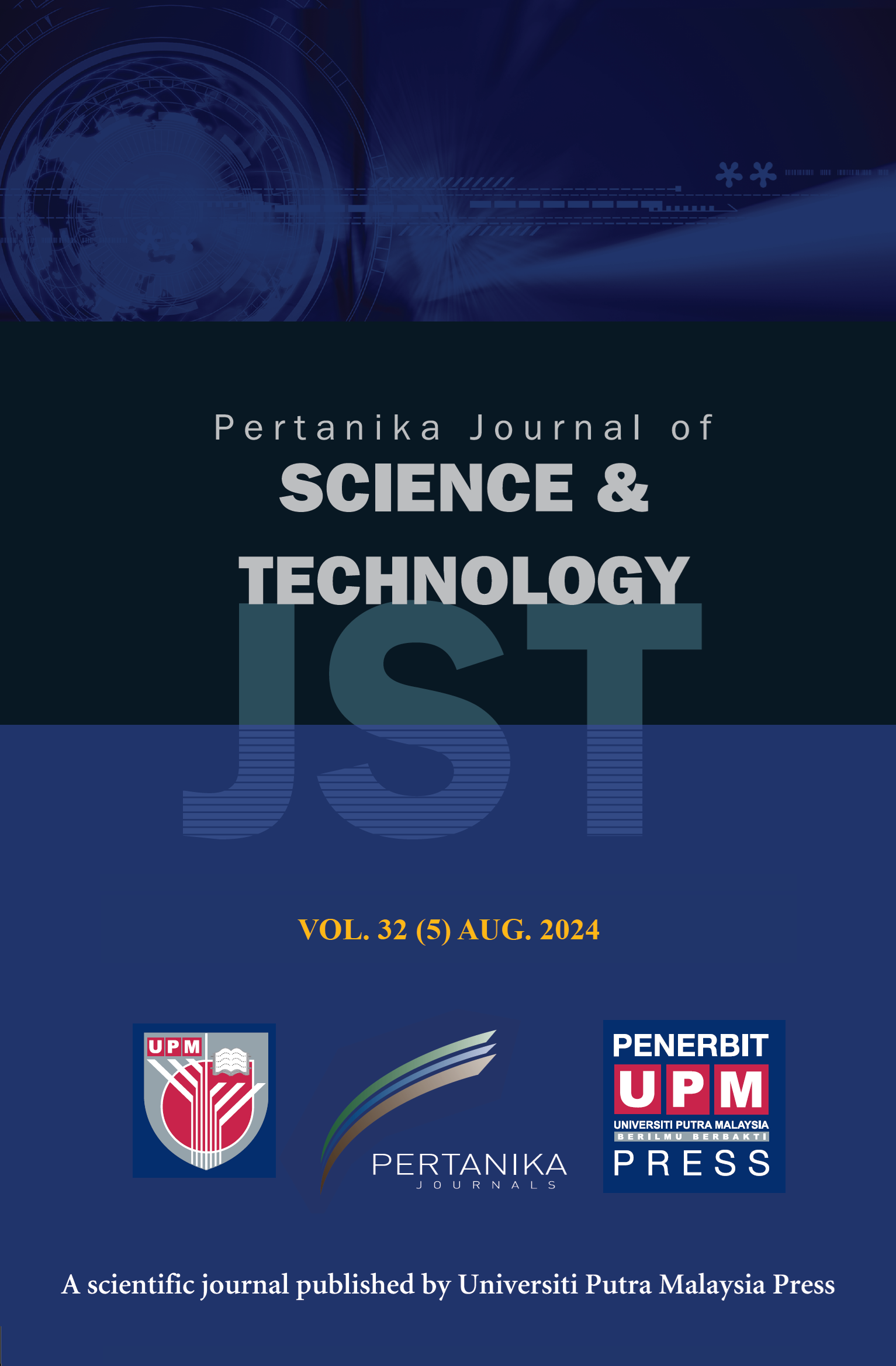PERTANIKA JOURNAL OF SCIENCE AND TECHNOLOGY
e-ISSN 2231-8526
ISSN 0128-7680
J
J
Pertanika Journal of Science & Technology, Volume J, Issue J, January J
Keywords: J
Published on: J
J
-
Akintunde, M. O., Adebayo-Tayo, B. C., Ishola, M. M., Zamani, A., & Horváth, I. S. (2022). Bacterial cellulose production from agricultural residues by two Komagataeibacter sp. strains. Bioengineered, 13(4), 10010–10025. https://doi.org/10.1080/21655979.2022.2062970
-
Amit, S. K., Uddin, M. M., Rahman, R., Islam, R., & Khan, M. S. (2017). A review on mechanisms and commercial aspects of food preservation and processing. Agriculture and Food Security, 6, 51. https://doi.org/10.1186/s40066-017-0130-8
-
Aswini, K., Gopal, N. O., & Uthandi, S. (2020). Optimized culture conditions for bacterial cellulose production by Acetobacter senegalensis MA1. BMC Biotechnology, 20, 46. https://doi.org/10.1186/s12896-020-00639-6
-
Azeredo, H. M. C., Barud, H., Farinas, C. S., Vasconcellos, V. M., & Claro, A. M. (2019). Bacterial cellulose as a raw material for food and food packaging applications. Frontiers in Sustainable Food Systems, 3, 7. https://doi.org/10.3389/fsufs.2019.00007
-
Cacicedo, M. L., Castro, M. C., Servetas, I., Bosnea, L., Boura, K., Tsafrakidou, P., Dima, A., Terpou, A., Koutinas, A., & Castro, G. R. (2016). Progress in bacterial cellulose matrices for biotechnological applications. Bioresource Technology, 213, 172–180. https://doi.org/10.1016/j.biortech.2016.02.071
-
Çakar, F., Özer, I., Aytekin, A. O., & Şahin, F. (2014). Improvement production of bacterial cellulose by semi-continuous process in molasses medium. Carbohydrate Polymers, 106, 7-13. https://doi.org/10.1016/j.carbpol.2014.01.103
-
Carrillo, F., Colom, X., Suñol, J. J., & Saurina, J. (2004). Structural FTIR analysis and thermal characterisation of lyocell and viscose-type fibres. European Polymer Journal, 40(9), 2229–2234. https://doi.org/10.1016/j.eurpolymj.2004.05.003
-
Chen, G., Wu, G., Chen, L., Wang, W., Hong, F. F., & Jönsson, L. J. (2019). Comparison of productivity and quality of bacterial nanocellulose synthesized using culture media based on seven sugars from biomass. Microbial Biotechnology, 12(4), 677–687. https://doi.org/10.1111/1751-7915.13401
-
Costa, A. F. S., Almeida, F. C. G., Vinhas, G. M., & Sarubbo, L. A. (2017). Production of bacterial cellulose by Gluconacetobacter hansenii using corn steep liquor as nutrient sources. Frontiers in Microbiology, 8, 2027. https://doi.org/10.3389/fmicb.2017.02027
-
Dikshit, P. K., & Kim, B. S. (2020). Bacterial cellulose production from biodiesel–derived crude glycerol, magnetic functionalization, and its application as carrier for lipase immobilization. International Journal of Biological Macromolecules, 153, 902-911. https://doi.org/10.1016/j.ijbiomac.2020.03.047
-
Esa, F., Masrinda, S. M., & Rahman, N. A. (2014). Overview of bacterial cellulose production and application. Agriculture and Agricultural Science Procedia, 2, 113–119. https://doi.org/10.1016/j.aaspro.2014.11.017
-
Gea, S., Reynold, C. T., Roohpour, N., Wirjosentono, B., Soykeabkaew, N., Bilotti, E., & Peijs, T. (2011). Investigation into the structural, morphological, mechanical and thermal behaviour of bacterial cellulose after a two-step purification process. Bioresource Technology, 102(19), 9105-9110. https://doi.org/10.1016/j.biortech.2011.04.077
-
Hestrin, S., & Schramm, M. (1954). Synthesis of cellulose by Acetobacter xylinum. 2. Preparation of freeze-dried cells capable of polymerizing glucose to cellulose. Biochemical Journal, 58(2), 345-352. https://doi.org/10.1042/bj0580345
-
Kacuráková, M., Smith, A. C., Gidley, M. J., & Wilson, R. H. (2002). Molecular interactions in bacterial cellulose composites studied by 1D FT-IR and dynamic 2D FT-IR spectroscopy. Carbohydrate Research, 337(12), 1145–1153. https://doi.org/10.1016/s0008-6215(02)00102-7
-
Klemm, D., Schumann, D., Udhardt, U., & Marsch, S. (2001). Bacterial synthesized cellulose - Artificial blood vessels for microsurgery. Progress in Polymer Science, 26(9), 1561–1603. https://doi.org/10.1016/S0079-6700(01)00021-1
-
Kongruang, S. (2008). Bacterial cellulose production by Acetobacter xylinum strains from agricultural waste products. Applied Biochemistry and Biotechnology, 148, 245. https://doi.org/10.1007/s12010-007-8119-6
-
Kouda, T., Naritomi, T., Yano, H., & Yoshinaga, F. (1998). Inhibitory effect of carbon dioxide on bacterial cellulose production by Acetobacter in agitated culture. Journal of Fermentation and Bioengineering, 85(3), 318-381. https://doi.org/10.1016/S0922-338X(97)85682-6
-
Moharram, M. A., & Mahmoud, O. M. (2007). FTIR spectroscopic study of the effect of microwave heating on the transformation of cellulose I into cellulose II during mercerization. Journal of Applied Polymer Science, 107(1), 30-36. https://doi.org/10.1002/app.26748
-
Movasaghi, Z., Rehman, S., & ur Rehman, D. I. (2008). Fourier transform infrared (FTIR) spectroscopy of biological tissues. Applied Spectroscopy Reviews, 43(2), 134-179. https://doi.org/10.1080/05704920701829043
-
Nguyen, Q.-D., Nguyen, T.-V.-L., Nguyen, T.-T.-D., & Nguyen, N.-N. (2022). Effects of different hydrocolloids on the production of bacterial cellulose by Acetobacter xylinum using Hestrin–Schramm medium under anaerobic condition. Bioresource Technology Reports, 17, 100878. https://doi.org/10.1016/j.biteb.2021.100878
-
Olszewska-Widdrat, A., Alexandri, M., López-Gómez, J. P., Schneider, R., & Venus, J. (2020). Batch and continuous lactic acid fermentation based on a multi-substrate approach. Microorganisms, 8(7), 1084. https://doi.org/10.3390/microorganisms8071084
-
Rahman, M. M., Netravali, A. N. (2016). Aligned bacterial cellulose arrays as “Green” nanofibers for composite materials. ACS Macro Letters, 5(9), 1070–1074. https://doi.org/10.1021/acsmacrolett.6b00621
-
Rebelo, A., Archer, A. J., Chen, X., Liu, C., Yang, G., & Liu, Y. (2018). Dehydration of bacterial cellulose and the water content effects on its viscoelastic and electrochemical properties. Science and Technology of Advanced Materials, 19(1), 203–211. https://doi.org/10.1080/14686996.2018.1430981
-
Ruka, D. R., Simon, G. P., & Dean, K. M. (2014). Bacterial cellulose and its use in renewable composites. In V. K. Thakur (Ed.), Nanocellulose polymer nanocomposites: Fundamentals and applications (pp. 89-130). Scrivener Publishing. https://doi.org/10.1002/9781118872246.ch4
-
Schrecker, S. T., & Gostomski, P. A. (2005). Determining the water holding capacity of microbial cellulose. Biotechnology Letters, 27, 1435-1438. https://doi.org/10.1007/s10529-005-1465-y
-
Thongwai, N., Futui, W., Ladpala, N., Sirichai, B., Weechan, A., Kanklai, J., & Rungsirivanich, P. (2022). Characterization of bacterial cellulose produced by Komagataeibacter maltaceti P285 isolated from contaminated honey wine. Microorganisms, 10(3), 528. https://doi.org/10.3390/microorganisms10030528
-
Väljamäe, P., Pettersson, G., & Johansson, G. (2001). Mechanism of substrate inhibition in cellulose synergistic degradation. European Journal of Biochemistry, 268(16), 4520–4526. https://doi.org/10.1046/j.1432-1327.2001.02377.x
-
Vollstedt, S., Xiang, N., Simancas-Giraldo, S. M., & Wild, C. (2020). Organic eutrophication increases resistance of the pulsating soft coral Xenia umbellata to warming. PeerJ, 8, e9182. https://doi.org/10.7717/peerj.9182
-
Wong, S. S., Kasapis, S., & Tan, Y. M. (2009). Bacterial and plant cellulose modification using ultrasound irradiation. Carbohydrate Polymer, 77(2), 280–287. https://doi.org/10.1016/j.carbpol.2008.12.038
-
Zahan, K. A., Hadzir, M. S. A., & Mustapha, M. (2017). The potential use of papaya juice as fermentation medium for bacteria cellulose production by Acetobacter xylinum 0416. Pertanika Journal of Tropical Agricultural Science, 40(3), 343-350.
ISSN 0128-7680
e-ISSN 2231-8526




